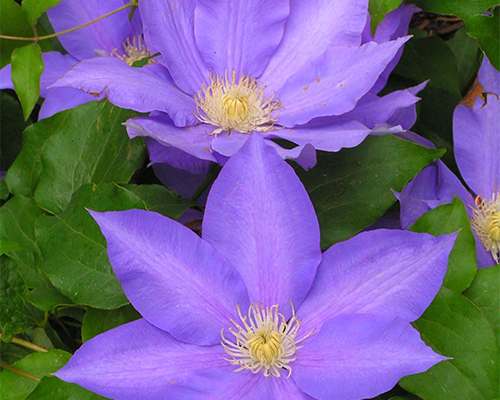Growing Clematis
“Where flowers bloom, so does hope.”
Lady Bird Johnson
Clematis plants are lovely flowering vines that are among the most popular grown in gardens. They do best with a trellis or structure to grow on. Clematis vary among species with different flowering forms, colors, and blooming seasons. Most bloom between late spring to fall.


Planting
- When planting clematis, make the planting hole 18 inches wide and deep.
- Enrich the soil in the bottom of the hole (and the soil that was removed from the hole) with a generous amount of compost and bone meal. Add lime if needed; clematis prefer a pH 5.5-7.0.
- Place a few inches of the back-fill soil mixture into the hole.
- Remove the clematis from its container and loosen the roots.
- Place your clematis on top of the fill, making sure the top of the root mass is almost level with the surface.
- Back fill around sides with the remainder of the soil mixture, firming the soil around the roots.
- Water well immediately after planting and for the next few weeks until roots become established.
Fertilizing
Clematis plants are heavy feeders and respond well to constant feeding. Two weeks or so after planting, apply a well-balanced liquid fertilizer and continue to do so every 2 weeks from April through the end of July according to label directions. A time-release fertilizer applied in spring when new growth begins to appear instead of liquid fertilizer will work well, too.
Shading Roots
Clematis must have cool, evenly moist roots. Shade them in summer with a light layer of organic mulch to keep the soil and roots cool and moist. You can also use other plants as a means to provide shade.
Training
Clematis is a twining, climbing vine that will do best with a trellis or structure to grow on. Direct the growth of young plants by loosely tying its shoots to a structure. Subsequent tying and a little selective pruning will keep the vine where you want it.
Pruning
Clematis fall into the three groups for pruning:
GROUP 1 – Alpine and Montana Types
Last year’s ripe stems produce this year’s flowers. Prune only as flowers fade or immediately thereafter before August 1st. If you prune any later the vine will not bloom the following year. Montanas love to ramble so do not prune unless it is taking over and is absolutely necessary.
GROUP 2 – Spring – Large Flowering
(Prune before new growth starts in spring)
This type produces flowers only on short 12-inch stems on the current year’s growth. No pruning is required except to remove dead stems. Light pruning can be done to keep the vine inbounds in early spring – but only before new growth starts.
GROUP 3 – Fall Flowering
(Hard pruning in March)
Flowers are produced only on vigorous new growth. Cut these clematis back hard in March. Cut back all stems from last year’s growth; remaining stem should be at least 12 inches long with at least 2 side buds. Train (tie-up) new growth as it climbs up in April and May.
Where to Plant Clematis
Clematis does best in a sunny location; a south or west-facing wall is preferred. They are also effective when grown under trees or on the north side of a low structure. Most are easily trained to grow on a trellis, arbor, tree or the roof of a structure, seeking the sun. Clematis prefer moist, well-drained soil.
Tools You Will Need
- Trellis
- Compost
- Lime
- Fertilizer
- Mulch
Download or print a PDF of Growing & Pruning Clematis
TOOL
